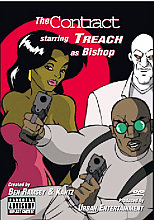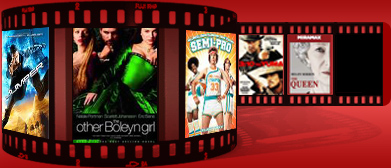Free Membership
Welcome to DVD-Movie-Sale.co.uk!
DVD Movie Sale is a comprehensive DVD site where you can search for any movie by genre, film title, actors name or director. Complete with full film information & synopsis as well as being able to compare prices for your favourite DVD from leading retail stores. You even have the opportunity to include your personal film reviews or give your personal ratings with numerous chances to win dvd related prizes.
Browse DVDs
Contract, The (Animated)
Contract, The (Animated)

Summary: A professional assassin rises through the ranks to become the point man for crime lord Damien Wiles. Includes hip hop soundtrack accompaniment.
Bishop is a hitman for hire who has worked his way up the ranks of Damien Wiles' crime syndicate. Damien assigns Bishop an important job, watching over the crime lord's girlfriend and waiting for the opportune time to assassinate her. Watching Cynda, Bishop becomes haunted by her innocence and beauty. Unsure of his feelings for Cynda and what it means to his loyalty he owes his employer, Bishop is further confused by the presence of the Milkman, who may be a supernatural being or a sign that Bishop is cracking up.
This unusual combination of gritty gangsta film and animation is a twist on an old theme complete with a streak of depravity. This compilation of episodes in the saga contains the complete series originally created for UrbanEntertainment.com and has spawned a live action remake, LOVE AND A BULLET.

WIN DVDS by being amongst the first to review this DVD. Reviewing DVDs earns you bonus entries and lets you WIN DVDs!Please login before reviewing this DVD. If you're a new user, register for free and enter to WIN FREE DVDs!

 "I try very hard never to distort or dissemble," says Mr. Neville (Anthony Higgins), a draughtsman of considerable talent contracted by a certain Mrs Herbert (Janet Suzman) to make 12 drawings for her absent husband of their English estate. Part of that contract involves Mr Neville taking his pleasure with Mrs Herbert. While Mr Neville aims for fidelity in his drawings, infidelity in private is quite another matter. The film becomes a cerebral puzzle when objects start appearing mysteriously in the subjects of Mr Neville's various drawings: a ladder that wasn't there before, a pair of boots standing in a field. Mr Neville's penchant for realism is stymied by these clues, which may or may not suggest the murder of Mr Herbert. Peter Greenaway seems to have directed this, his first art-house success, with the aim of exploring the failings of perspective in art and casting his doubtful eye on the possibility of "faithful" drawings such as those by which Mr. Neville makes his living. Greenaway was, after all, an art student, and must have known that drawing machines like the one Mr Neville uses in the film (which is set in 1694) led not only to the invention of photography, and therefore of film itself, but also to the renouncing of perspective that informs so much of 20th-century painting.
"I try very hard never to distort or dissemble," says Mr. Neville (Anthony Higgins), a draughtsman of considerable talent contracted by a certain Mrs Herbert (Janet Suzman) to make 12 drawings for her absent husband of their English estate. Part of that contract involves Mr Neville taking his pleasure with Mrs Herbert. While Mr Neville aims for fidelity in his drawings, infidelity in private is quite another matter. The film becomes a cerebral puzzle when objects start appearing mysteriously in the subjects of Mr Neville's various drawings: a ladder that wasn't there before, a pair of boots standing in a field. Mr Neville's penchant for realism is stymied by these clues, which may or may not suggest the murder of Mr Herbert. Peter Greenaway seems to have directed this, his first art-house success, with the aim of exploring the failings of perspective in art and casting his doubtful eye on the possibility of "faithful" drawings such as those by which Mr. Neville makes his living. Greenaway was, after all, an art student, and must have known that drawing machines like the one Mr Neville uses in the film (which is set in 1694) led not only to the invention of photography, and therefore of film itself, but also to the renouncing of perspective that informs so much of 20th-century painting.
In the film, Greenaway overlays the story's mysterious elements with highly mannered tableaux, shooting each scene like a realistic, though sumptuous, painting, while his actors spout witty and complicated sentences, suggesting the falseness of surfaces. Mr Neville's faith in surface is his downfall, and Greenaway's triumph is in his distortions and dissemblings, the narrative lie that gets closer to the truth than any architectural drawing could. --Jim Gay, Amazon.com























